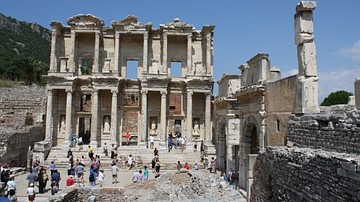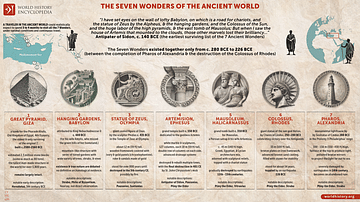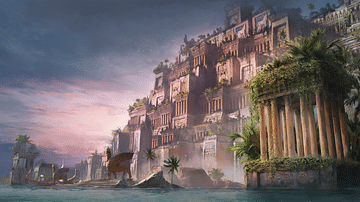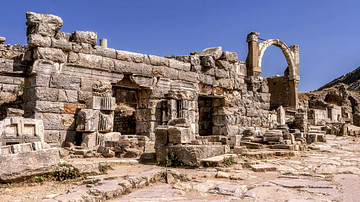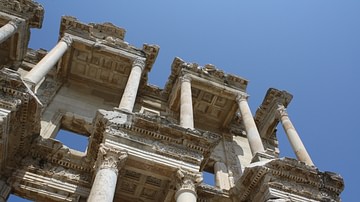
The Temple of Artemis at Ephesus was located on the western coast of Asia Minor (modern Turkey) and built in the 6th century BCE. Such was its tremendous size, double the dimensions of other Greek temples including the Parthenon, that it was soon regarded as one of the Seven Wonders of the Ancient World.
Destroyed by a deliberate fire in the 4th century BCE and then rebuilt, the great Ionic temple survived until Late Antiquity and the Gothic invasion of c. 267 CE. Once again rebuilt, in 401 CE it was torn down for the last time by a Christian mob. Today only the foundations and a solitary column stand as a reminder of the site where once stood the greatest temple in the ancient Mediterranean.
Artemis & Ephesus
Ephesus (or Ephesos) was a Greek colony on the eastern coast of Asia Minor founded in the 8th century BCE, although there had been Greek settlers in the area from c. 1200 BCE. The Greek goddess Artemis (Diana to the Romans) was particularly important to the Ephesians, indeed her birthplace was considered by them as nearby Ortygia (for other Greeks it was Delos). Artemis was the goddess of chastity, hunting, wild animals, forests, childbirth, and fertility. The goddess' cult at Ephesus included eastern elements (borrowed from goddesses such as Isis, Cybele, and the “Mistress of the Animals”), as did her representation in art, with surviving statues, unlike elsewhere in Greece, being covered in eggs as symbols of her role as a fertility goddess. Hence, the goddess worshipped at Ephesus is often referred to as Artemis Ephesia.
The city had an up and down relationship with the neighbouring kingdom of Lydia, resisting many attacks but at the same absorbing some cultural elements. The Lydian king Croesus (r. 560-546 BCE) conquered Ephesus between 560 and 550 BCE, and then funded the construction of new buildings, including a great new temple to Artemis or, as the Greek historian Herodotus put it, he “dedicated many columns” (Histories, 1.92). An interesting archaeological find at the site was a column drum carrying the inscription 'dedicated by Croesus'.
There had already been several versions of the temple over the centuries at Ephesus, and Herodotus describes the Ephesians tying a rope 1243 metres (4081 ft) long between the old temple and the city in a desperate and as it turned out futile hope that their dedication of the entire city to Artemis would save them from the Lydians.
The Temple
The magnificent new Ionic temple was supervised by, according to the 1st-century CE Roman writer Pliny the Elder, the master architect Chersiphron of Knossos while Strabo, the Greek geographer (c. 64 BCE - c. 24 CE), reports that credit should go to both Chersiphron and his son Metagenes. However, both figures may have actually lived in the 8th century BCE and so been involved in the very first version of the temple. Nevertheless, a treatise on the temple written in the mid-6th century BCE is attributed to Chersiphron and Metagenes. Vitruvius, the 1st-century BCE Roman architect and writer, has the project begun by the former pair and completed by Paeonius of Ephesus.
Begun c. 550 BCE, the marble temple would take 120 years to complete, and like its predecessors, it was dedicated to Artemis and so was sometimes referred to as the Artemisium (or Artemision). Like most temples to the goddess in the Greek world, it was located a short distance from the city as Artemis was thought to preside over boundaries (physical or otherwise), wild vegetation, animals, and nature in general. According to Pliny the Elder in his Natural History (36.97), the temple measured 129.5 metres (425 ft) in length and was 68.6 metres (225 ft) wide, almost double the size of the 5th-century BCE Parthenon at Athens (69.5 x 30.9 m). It had 127 columns which were 18.3 metres (60 ft) high and 1.2 metres (4 ft) in diameter. The columns were arranged in a double row on all four sides, eight or nine on the short sides and 20 or 21 on the long sides. Those columns on the facades were decorated with relief figures from Greek mythology.
The decorative frieze of the temple carried scenes involving Amazons, who were, in Greek mythology, supposed to have sought shelter at Ephesus from Hercules. The architrave blocks above the columns are estimated to have weighed 24 tons each, and the feat of engineering that put them in place led to the Ephesians believing it was the work of Artemis herself. According to Vitruvius in his On Architecture (2.9.13), the cult statue of Artemis which stood within the temple (and for which the whole project was actually started) was made of cedar wood.
The foundations of the temple have received some attention, first by Pliny the Elder who praises the engineer and sculptor Theodorus of Samos for preparing them on marshy ground and thus mitigating the effect of earthquakes. Pliny also notes that alternate layers of sheepskins and packed charcoal were used to provide the necessary stability to support the massive weight of the structures about to be built on top. Excavations at the site in 1870 CE did indeed reveal that the foundations of the temple were composed of layers of a soft mortar substance and charcoal. Layers of marble chips and charcoal have also been discovered in 20th century CE excavations, but neither explorations have found evidence of sheepskins.
Destruction & Rebuilding
In the 4th century BCE, the temple partially funded by Croesus was destroyed by a fire deliberately started by a man called Herostratus, who became one of history's most infamous arsonists, his sole ambition in committing the crime. According to the Greek writer Plutarch (c. 45-125 CE) in his biography of Alexander the Great, the great Macedonian leader was born on the very same day that the Temple of Artemis burnt down, around 21 July 356 BCE (the 6th day of Hecatombaeon). Remembering that Artemis was the goddess of childbirth, Plutarch noted:
It was this coincidence which inspired Hegesias of Magnesia to utter a joke which was flat enough to have put the fire out: he said it was no wonder the temple of Artemis was destroyed, since the goddess was busy attending to the birth of Alexander. But those of the Magi who were then at Ephesus interpreted the destruction of the temple as the portent of a far greater disaster, and they ran through the city beating their faces and crying out that that day had brought forth a great scourge and calamity for Asia. (254)

Despite these dire predictions, the temple was rebuilt on the same spot and following the same design as the original, even better according to Strabo (Geography, 14.1.21). Excavations, though, have revealed the Hellenistic temple was slightly smaller than its predecessor, measuring some 105 x 55 metres (344 x 180 ft) with columns 17.65 metres (58 ft) high. In addition, the new version was placed on a higher base to make the temple more imposing. The architect in charge was either Kheirocrates or Deinocrates, according to Vitruvius. Strabo also notes that Alexander, visiting Ephesus in 334 BCE, offered to pay the expenses of the ongoing construction if his name appeared on an inscription on the finished temple. The Ephesians refused the offer, one unnamed man declaring that it was not correct for one god to present gifts to another god, and instead, the Ephesians paid for it themselves by having a collection of the citizens' personal jewellery.
The Seven Wonders
Some of the monuments of the ancient world so impressed visitors from far and wide with their beauty, artistic and architectural ambition, and sheer scale that their reputation grew as must-see (themata) sights for the ancient traveller and pilgrim. Seven such monuments became the original 'bucket list' when ancient writers such as Herodotus, Callimachus of Cyrene, Antipater of Sidon, and Philo of Byzantium compiled shortlists of the most wonderful sights of the ancient world. The Temple of Artemis at Ephesus made it onto the established list of Seven Wonders because of its size and beauty; the location right next to the sea (which since antiquity has retracted several kilometres) must also have contributed to the mesmerising effect of the building. Indeed, the Temple of Artemis was often cited as the greatest of the seven wonders by those who had seen them. Pliny the Elder described the temple as “the most wonderful monument of Græcian magnificence” (Natural History, 36.97). Pausanias, the 2nd-century CE Greek travel writer, in his Description of Greece, described the size of the temple as "surpassing all buildings among men" (4.31.8).
Ephesus continued to be an important city into Roman times and was made capital of the Roman province of Asia after 129 BCE. This prosperity brought unwelcome attention, though, and the temple of Artemis was destroyed yet again, or at least plundered, by the Goths during their invasion of the Aegean c. 267 CE. Although subsequently rebuilt or restored, a Christian mob, inspired by the decree of Roman emperor Theodosius I (r. 379-395 CE) against pagan practices in 393 CE, definitively destroyed the temple in 401 CE. In the following centuries, the area gradually became covered by silt from the regular floods of the nearby river Kaystros, even if Ephesus itself continued as an important Byzantine city until it was captured by the Turks in 1304 CE.
The Temple of Artemis was not forgotten, and a tradition sprang up in medieval times that some of the columns of the Hagia Sophia in Constantinople were looted from it, but the noted Byzantine specialist Cyril Mango points out that this idea is absurd. Certainly, blocks from the temple were reused in many buildings at Ephesus, a common practice in antiquity.
Such was the legendary splendour of the Temple of Artemis that it was the very first ancient site that 19th-century CE western archaeologists deliberately went digging for. It was found in 1869 CE by John Turtle Wood. Excavations began under the auspices of the British Museum in London, and they discovered several important artefacts such as fine marble figures of Artemis Ephesia dating to the 1st and 2nd century CE. The remains of the great temple were also found, and during another series of excavations from 1904 CE, more details were revealed. The oldest artefacts, typically votive offerings made of precious metals, date to the 7th century BCE. Several capital and column pieces have been discovered from the 6th-century CE version of the temple, while one of the best finds was a magnificently carved column drum from the Hellenistic version. The drum, which has several figures carved in relief including Hades, Persephone, and Hermes, is now in the British Museum. Today all that remains of the temple are its foundations, and a single column has been erected from composite remains which, rather than giving an impression of lost grandeur, gives a melancholic air to the site which was once one of the most wondrous in the ancient Mediterranean.





